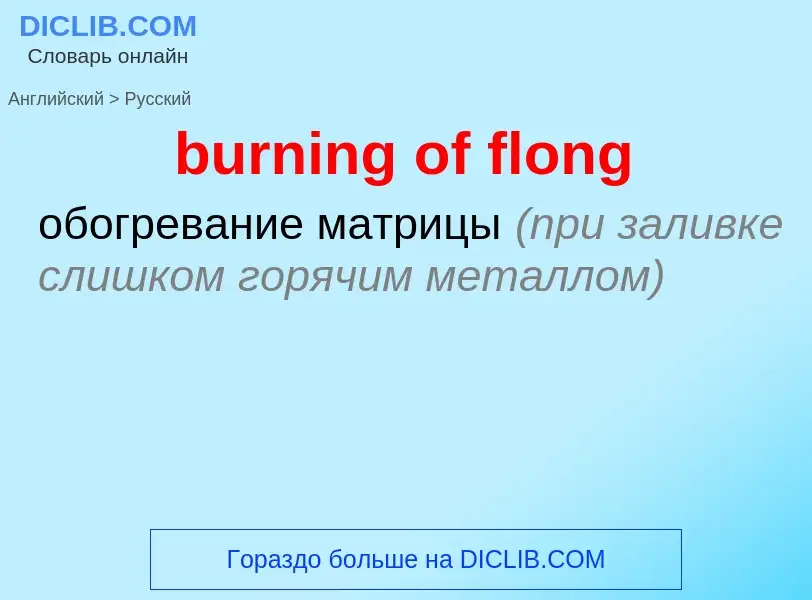Перевод и анализ слов искусственным интеллектом ChatGPT
На этой странице Вы можете получить подробный анализ слова или словосочетания, произведенный с помощью лучшей на сегодняшний день технологии искусственного интеллекта:
- как употребляется слово
- частота употребления
- используется оно чаще в устной или письменной речи
- варианты перевода слова
- примеры употребления (несколько фраз с переводом)
- этимология
burning of flong - перевод на русский
['bə:niŋ]
общая лексика
выжигание
сжигание
огневая очистка
пал
ожог
горение
выгорание
обгорание
прокаливание
обжиг
обжигание
пережог
окисление (металла)
пригорание (напр., контактов)
подгорание
прожог
горящий
добыча полезных ископаемых
прострелка шпуров или скважин
полиграфия
пересушивание (бумаги)
медицина
жжение (ощущение)
нефтегазовая промышленность
прострелка (скважин)
Смотрите также
прилагательное
общая лексика
горячий
пылающий
горючий
горящий
эмоциональное выражение
жгучий
нестерпимый
синоним
существительное
['bə:niŋ]
общая лексика
горение
обжиг
прокаливание
окисление (металла)
обжиг, обжигание
сельское хозяйство
пал
устаревшее выражение
жар
добыча полезных ископаемых
расширение (шнуров) взрывами
общая лексика
жгучий вопрос
['bibliəklæst]
существительное
общая лексика
человек
уничтожающий или портящий книги
Определение
.
Википедия

The burning of Judas is an Easter-time ritual that originated in European Christian communities where an effigy of Judas Iscariot is burned. Other related mistreatment of Judas effigies include hanging, flogging, and exploding with fireworks. A similar ritual in Jewish tradition would be the hanging and burning an effigy of Haman and his ten sons during Purim, although this is not a widespread contemporary practice.
Though not an official part of the Easter liturgical cycle, the custom is typically a part of the reenactment of the story of the Passion that is practiced by the faithful during Easter. Customs vary, but the effigy of Judas is typically hanged (reenacting Matthew 27:5) on Good Friday, then burned on the night of Easter Sunday.
In many parts of Latin America this practice occurs on the eve of the New Year as a symbol of ridding one's self of evil and beginning a new year in spiritual purity. Some communities observe this ritual using various effigies, including the biblical Judas (who betrayed Jesus). This custom, during which the effigy is burned on a stake, is called "Quema del Judas" ("the burning of Judas") in Uruguay and Argentina, and "Quema del Año Viejo" ("the burning of the old year") in other places.


![Burning of Judas in [[Juiz de Fora]], [[Brazil]], 1909 Burning of Judas in [[Juiz de Fora]], [[Brazil]], 1909](https://commons.wikimedia.org/wiki/Special:FilePath/Academia de Comercio - Queima do Judas (1909).jpg?width=200)
![Creating a Judas figure in form of a devil at a workshop at the [[Museo de Arte Popular, Mexico City]] Creating a Judas figure in form of a devil at a workshop at the [[Museo de Arte Popular, Mexico City]]](https://commons.wikimedia.org/wiki/Special:FilePath/Judas TallerMAP.jpg?width=200)
![Shooting at the gallows of the [[effigy]] of Judas Iscariot, [[Santorini]], Greece, April 2010 Shooting at the gallows of the [[effigy]] of Judas Iscariot, [[Santorini]], Greece, April 2010](https://commons.wikimedia.org/wiki/Special:FilePath/The Burning of Judas (4491213472).jpg?width=200)




![''Killing the Scholars and Burning the Books'']] in 210–213 BC (18th-century Chinese painting) ''Killing the Scholars and Burning the Books'']] in 210–213 BC (18th-century Chinese painting)](https://commons.wikimedia.org/wiki/Special:FilePath/Killing the Scholars, Burning the Books.jpg?width=200)
![Symbol of the "[[New York Society for the Suppression of Vice]]", advocating book-burning Symbol of the "[[New York Society for the Suppression of Vice]]", advocating book-burning](https://commons.wikimedia.org/wiki/Special:FilePath/NewYorkSocietyForTheSuppressionOfVice.jpg?width=200)
![Copies of books which were burned by the Nazis, on display at [[Yad Vashem]] Copies of books which were burned by the Nazis, on display at [[Yad Vashem]]](https://commons.wikimedia.org/wiki/Special:FilePath/Yad Vashem Books burned by Nazis by David Shankbone.jpg?width=200)
